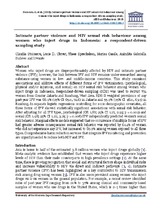Intimate partner violence and HIV sexual risk behaviour among women who inject drugs in Indonesia: a respondent‑driven sampling study Claudia Stoicescu,
Date
2018Author
Stoicescu, Claudia
Cluver, Lucie D.
Spreckelsen, Thees
Casale, Marisa
Sudewo, Anindita Gabriella
Irwanto
Metadata
Show full item recordAbstract
Women who inject drugs are disproportionately affected by HIV and intimate partner violence (IPV); however, the link between IPV and HIV remains under-researched among substance-using women in low- and middle-income countries. This study examined associations and additive effects of different forms of IPV victimization (psychological, physical and/or injurious, and sexual) on HIV sexual risk behavior among women who inject drugs in Indonesia. Respondent-driven sampling (RDS) was used to recruit 731 women from Greater Jakarta and Bandung, West Java. RDS-II weighted prevalence of any past-year IPV was 68.9% (95% CI 65.0, 72.6) in Jakarta and 55.9% (95% CI 48.0, 63.5) in Bandung. In separate logistic regressions controlling for socio-demographic covariates, all three forms of IPV showed statistically significant associations with sexual risk behavior. After adjusting for all IPV types, psychological (OR 1.87; 95% CI 1.17, 2.99; p = 0.009) and sexual (OR 1.98; 95% CI 1.22, 3.21; p = 0.006) IPV independently predicted women’s sexual risk behavior. Marginal effects models suggested that co-occurrence of multiple forms of IPV had greater adverse consequences: sexual risk behavior was reported by 64.1% of women who did not experience any IPV, but increased to 89.9% among women exposed to all three types. Comprehensive harm reduction services that integrate IPV monitoring and prevention are urgently needed to reduce both HIV and IPV.

